Single Phase Full House Wiring | full house wiring Diagram,
Single Phase Full House Wiring:
This Diagram Shyows Single-Phase Power is a 2-wire alternating Current Power Circuit. There is 1 Power Wire The Phase Wire and 1 Neutral Wire, With Current Flowing Between The Power Wire and The Neutral Wire. In a Single-Phase Power Supply, The Power is Supplied Through 2 ires Called Phases and Neutral. In Three-Phase Power Supply The Power is Supplied Through Three Wires.
Diagram of Single Phase Full House wiring:
 |
| Fig 1: Single Phase Full House Wiring |
Components Need for this Project:
You can get the components from any of the sites below:
- DP MCB [See Buy Click Amazon]
- SPD [See Buy Click Amazon]
- RCBO [See Buy Click Amazon]
- SP MCB [See Buy Click Amazon]
- Room Socket [See Buy Click Amazon]
- Speed Regulator [See Buy Click Amazon]
- Ceiling Fan [See Buy Click Amazon]
- Bulb [See Buy Click Amazon]
- Fluorescent Lamp [See Buy Click Amazon]
*Please note: These are affiliate links. I may make a commission if you buy the components through these links. I would appreciate your support in this way!
$ads={1}Read Also:
Components used to make the Single Phase Full House Wiring:
01. DP MCB
 |
| Fig 2: DP MCB |
Double pole MCB can control two wires. This circuit breaker is generally used in single-phase electric lines. Double pole MCB circuit breaker input has two wires supply two wires and an output. In a single-phase line, A double-pole MCB circuit breaker is used to give good production. This circuit breaker is provided through phase and neutral circuit breaker, it is very safe. This circuit breaker is preferred for home appliances. A DP MCB usually trips for 2 reasons 1. Overload 2. Short circuit.
02. SPD
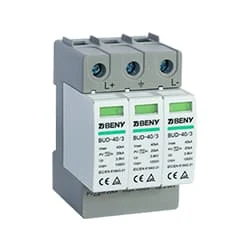 |
| Fig 3: SPD |
A surge protection device (SPD) or more commonly a surge protector is a device used to protect electronic devices from power surges or transient voltages. A surge protective device is a protective device that limits transient voltages or limits surge current. Surge Protective Devices are Used to Protect Sensitive Electronic Equipment Connected to the Installation such as Computers, Televisions, Washing Machines, and Safety Circuits such as fire Detection Systems and Emergency Lighting. Equipment with Sensitive Electronic Circuitry may be Vulnerable to Damage by Transient Overvoltages.
03. RCBO
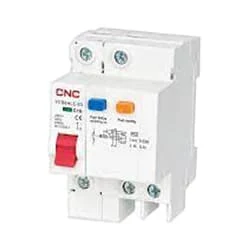 |
| Fig 4: RCBO |
RCBO Stands For Residual Current Circuit Breaker With Over-Current. These devices are designed to ensure the safe operation of electrical circuits breaker, triggering disconnection whenever an imbalance is detected. The other type of electrical fault is the overcurrent flow, which may take the form of an overload or short circuit. The residual current circuit breaker (RCBO) insulation should also operate within the corresponding specifications. This thereby provides protection for people, equipment, and property.
04. SP MCB
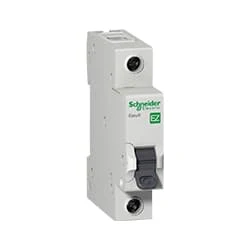 |
| Fig 5: SP MCB |
MCB SP means single pole it protects only one phase switching. MCB (Miniature Circuit Breaker) Curswitch is the most basic general-purpose switch that you use to control a light or another device from one location. These Switches Have Two Brass-Colored Screw Terminals Connected to the hot Power Source Wires. (MCB) For any Distribution Board, the Protection System Must be Used in The Incomer. Phase and Neutral Single Phase Supply to break. 120-volt circuits, 15-20 amp single pole breaker is typically used.
05. Room Socket
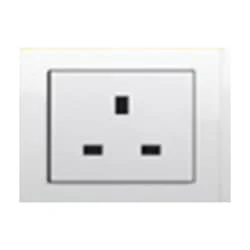 |
| Fig 6: Room Socket |
A socket is a type of equipment used in electrical wiring lines that always has an electrical connection. According to the need, it can be supplied to the electrical equipment. In case of electric iron, electric hand drill machine and electric hand grinder etc. two-pin socket with earth terminal is used. Also, three-pin sockets are used for electrical appliances that have a metal body and are likely to be electrified. Eg – Refrigerator, room heater, table heater, hot-plate, electric oven etc.
06. Speed Regulator
 |
| Fig 7: Speed Regulator |
Reduces fan speed by switching on and off. Reducing the speed of the fan, the power Consumption is also Reduced. It is basically a wire wood resistor-based regulator. The large regulators that were used in the past took up more than half of the switchboard space and were very hot. It looks very small in size. Almost equal to a switch. Electrical regulators are basically made by winding copper wire on an iron core. As Electricity Travels Long Distances Through These Wires, Some of The Electrical Energy is Converted Into Heat Energy.
07. Ceiling Fan
 |
| Fig 8: Ceiling Fan |
The main driving force behind all ceiling fan systems is the motor used inside the fan. We can also compare it with the soul of a fan. This motor converts the supplied electrical energy into mechanical energy which turns the ceiling fan and gives us air. When current is supplied, the magnetic field formed on the positive half-cycle becomes the reverse magnetic field on the next negative half-cycle. The magnitude part does not rotate and the capacitor is converted to a phase when it is connected to a phase motor or ceiling fan with a helical coil or stationing coil. When power is supplied there is a magnetic difference between the phase currents and the coils (acting as two phases) so that the motor or fan rotates.
08. Bulb
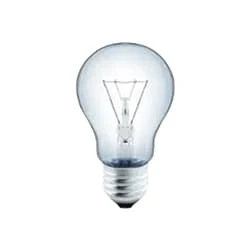 |
| Fig 9: Bulb |
CFLs work in a completely different way from ordinary lamps, they work by using a different process called fluorescence rather than generating light from heat. A typical light bulb wastes 90% of energy and converts only 10% of energy into light, this is where CFL has the biggest advantage. CFL- Curved or conical glass tube filled with argon and a small amount of mercury vapor. The inner wall of the glass is coated with fluorescent material. CFL- It is manufactured using the principle of creating fluorescent light. CFL- Originally white in color but now the construction and use of CFLs producing colored light has become popular.
09. Fluorescent Lamp
 |
| Fig 10: Fluorescent Lamp |
A fluorescent lamp, tube light, or rod light is a type of electric lamp that uses electricity to excite mercury vapor to produce light. These lamps are mainly used as an artificial source of light. When the mercury vapor inside a fluorescent lamp is excited with electricity, the mercury molecules emit short-wavelength ultraviolet light that hits fluorescent particles to produce visible light. Fluorescent lamps always require a ballast to control the flow of electrical energy inside the lamp, which is required by incandescent lamps. is not.
Thank You for visiting the website. Keep visiting for more Updates
$ads={2}
Frequently Asked Questions
What is single-phase house wiring?
Single phase supply consists of one phase wire called hot wire and one neutral wire connected to the Energy meter by PSPCL as input supply 220V. The output 220V supply is taken from the Energy meter to the MCB distribution box. ELCB, DP MCB / Isolator is used as the main control.
What is a single-phase connection for a home?
When it comes to distributing power, a single-phase connection uses neutral and phase wires. The neutral wire acts as a returning path for the power supply current and the phase wires carry the load. In a single-phase connection, the voltage starts at 230 Volts and has a frequency Circuit diagram about 50 Hertz.
Why does single-phase have 2 wires?
Single phase means you have 2 wires coming from the power supply street, an active wire, usually red, and a neutral wire, as always black. To simplify, in a single-phase power supply, the energy flows in via the active, through your meter and main switch, and onward via RCD/circuit diagram breakers, into the wiring, and to your power supply appliances.
What is single-phase home voltage?
The two wires that come into your home, are the one that is connected to the phase conductor called Live wire and the other one which is connected to the neutral wire called Neutral. The current that you receive through the live wire is called Single-phase current, 230 volts (standard).
How do I know my meter load capacity?
You can read this meter using the LCD display. To read your kW demand, wait for the Circuit diagram meter LCD display to cycle to code 10. The code is displayed in area 3. Your maximum kW for the Circuit diagram day will be displayed; this is the maximum and average load over a 15- or 30-minute interval (depending on your price plan) for the power supply day.











Post a Comment
Do leave your comments